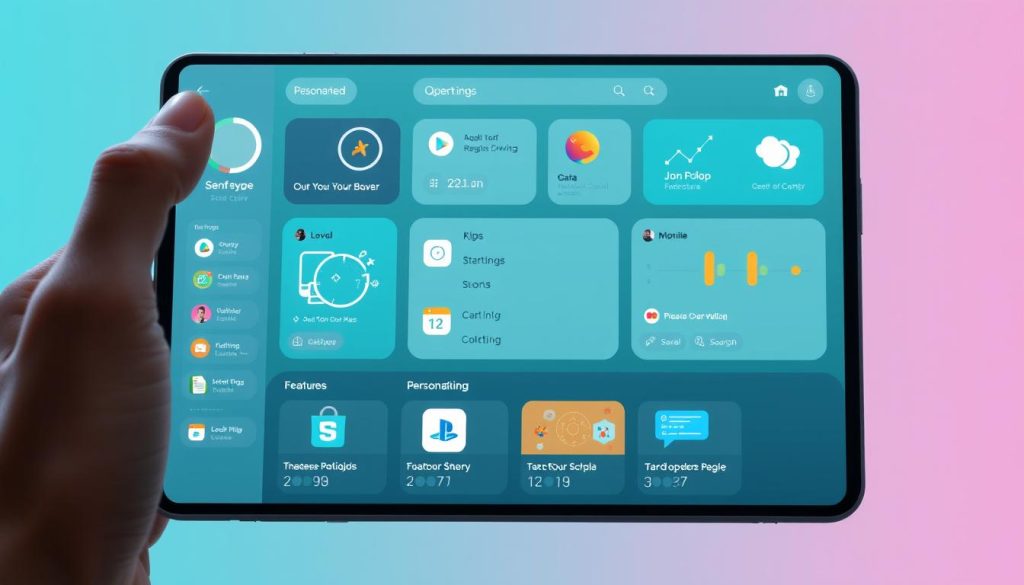Software companies need more than just a quality product to stand out. Personalized marketing can boost sales and customer loyalty. This approach tailors promotional efforts to your audience’s unique needs and preferences.
By doing so, you create a more engaging and effective marketing strategy. This leads to increased software adoption and stronger customer relationships.
Key Takeaways
- Personalized marketing can significantly improve user engagement and software adoption rates.
- Gathering and analyzing user data is crucial for creating targeted, personalized campaigns.
- Leveraging user behavior analytics and dynamic content can enhance the customer experience.
- Optimizing landing pages and integrating personalization throughout the marketing funnel are key to driving conversions.
- Measuring the success of personalized marketing strategies and adhering to best practices are essential for long-term success.
Understanding the Power of Personalized Marketing
Personalization is revolutionizing software marketing. It tailors messages, content, and offers to individual users. This approach boosts engagement and allows effective customer segmentation.
Personalized marketing delivers content that resonates with unique needs and preferences. It unlocks powerful benefits for businesses and customers alike.
Personalization’s Impact on User Engagement
Personalized marketing significantly boosts user engagement. Users feel understood when brands cater to their specific needs. This leads to more active interaction with content and offerings.
Increased engagement often results in higher conversion rates. It also builds stronger brand loyalty. Users develop meaningful relationships with software companies that personalize their experience.
Tailoring Content for Different Customer Segments
Customer segmentation is crucial for personalized marketing success. Companies analyze user data to identify distinct customer groups. This allows them to create content that resonates with each segment.
A targeted approach ensures users receive relevant information. This drives higher engagement and conversions. It makes the user experience more valuable and efficient.
| Customer Segment | Personalized Content Strategies |
|---|---|
| New Users | Onboarding tutorials, product feature highlights |
| Experienced Users | Advanced tutorials, feature updates, cross-sell opportunities |
| Power Users | Exclusive content, beta access, customization options |
Personalized marketing benefits create engaging user experiences. This drives higher user engagement strategies and increased conversions. Data-driven content creation helps companies achieve these goals effectively.
Gathering User Data for Personalized Marketing Campaigns
Collecting and analyzing user data is key to effective personalized marketing. Understanding your audience helps create engaging, tailored campaigns. Let’s explore various data sources and their ethical use.
Uncover Insights from Website Analytics
Website analytics offer valuable information about users’ online activities. Track metrics like page views and conversion rates to identify popular content. This data helps optimize digital experiences and build personalized marketing strategies.
Tap into In-App User Interactions
In-app user data provides deep insights for software products. Track feature usage and time spent in-app to understand customer interactions. Use this data to personalize feature recommendations and onboarding processes.
Leverage Customer Surveys and Feedback
Direct customer engagement through surveys uncovers valuable qualitative data. Ask about pain points and preferences to understand your target audience better. Use this information to guide personalized messaging and product improvements.
Prioritize privacy and transparency when gathering user data. Implement clear policies and obtain explicit consent to protect user information. Balance personalization with data stewardship to build trust and deliver tailored experiences.
| Data Source | Key Insights | Privacy Considerations |
|---|---|---|
| Website Analytics | User behavior, content preferences, conversion rates | Anonymize data, obtain consent for tracking, comply with privacy regulations |
| In-App Interactions | Feature usage, user flow, engagement levels | Obtain explicit consent, anonymize or aggregate data, provide transparency |
| Customer Surveys | Pain points, preferences, desired experiences | Voluntary participation, protect survey responses, respect data privacy |
Using diverse user data sources helps develop a comprehensive understanding of your audience. This knowledge enables creation of personalized marketing campaigns that drive engagement and conversions.

How To Promote Software Using Personalized Marketing
Personalized marketing is a powerful tool for software promotion in the digital age. It uses user behavior analytics to gain valuable insights. These insights help create targeted campaigns that resonate deeply with customers.
Leveraging User Behavior Analytics
Understanding user behavior is crucial for effective personalized marketing. Marketers analyze browsing history, purchase patterns, and engagement levels to identify customer segments. This data-driven approach allows for tailored software promotions that address specific audience needs.
Crafting Targeted Email Campaigns
Email marketing is essential for personalized software promotion. User behavior analytics help create engaging email campaigns. Strategies like dynamic content and product recommendations can boost engagement and conversion rates.
| Personalization Tactic | Potential Impact |
|---|---|
| Dynamic Product Recommendations | Increase in conversion rates by up to 30% |
| Personalized Subject Lines | Boost in open rates by up to 26% |
| Triggered Abandoned Cart Emails | Average cart recovery rate of 45% |
Software companies can effectively promote their products using user behavior analytics. This approach helps target the right audience at the right time. It drives meaningful growth and success for businesses.
Creating Personalized In-App Experiences
Software providers can boost user loyalty with dynamic content personalization. This approach enhances the user’s journey within applications. It drives long-term software adoption and fosters deeper user-centric software engagement.
Tailoring Content Based on User Preferences
Apps can adjust content using user data and behavioral analytics. This helps match individual user needs. Personalization can include product recommendations based on past interactions.
It may also suggest relevant tutorials to support user goals. Customizing the interface layout to match usage patterns is another option.
A user-centric software experience builds stronger connections. It boosts user engagement and improves software adoption rates.
Optimizing Content Delivery for Maximum Impact
Dynamic content personalization involves monitoring user behavior. It adjusts content delivery in real-time for better results. This can include timely notifications based on the user’s current context.
Adapting content format to suit device preferences is crucial. Personalizing messaging to address unique needs enhances user experience.
Optimizing personalized content delivery maximizes the impact of personalized in-app experiences. This leads to higher user satisfaction and conversion rates.

Personalized in-app experiences require understanding user behavior and preferences. Investing in these strategies fosters stronger engagement. It promotes loyalty and ensures long-term software adoption.
Optimizing Landing Pages for Personalized Conversion
Landing pages are vital for customer journeys. Personalized landing page optimization can boost conversion rate improvement. A user-focused design creates tailored experiences that resonate with audiences and boost engagement.
Dynamic content on landing pages is an effective strategy. It delivers personalized messages, images, and calls-to-action based on user data. This creates a more relevant experience, leading to increased conversions.
Targeted messaging is crucial for optimizing landing pages. Understand your customer segments’ unique needs and preferences. Craft copy that directly addresses their concerns.
| Personalization Tactic | Conversion Rate Improvement |
|---|---|
| Dynamic Content Delivery | 19% increase |
| Targeted Messaging | 24% increase |
| User-Centric Design | 17% increase |
These strategies create engaging landing page experiences. They drive higher conversion rate improvement for your software product. Personalization is key to standing out in today’s competitive market.
“Personalization is no longer a nice-to-have, but a necessity in today’s competitive landscape. Brands that fail to deliver a tailored experience will struggle to stand out and retain customers.”
Integrating Personalization Throughout the Marketing Funnel
Personalized marketing goes beyond a single campaign or touchpoint. It’s crucial to weave it into the entire marketing funnel. This approach helps nurture leads with relevant content and guide them through their journey.
Nurturing Leads with Relevant Content
Successful lead nurturing strategies rely on personalized, value-driven content. Using customer data and behavioral insights, businesses can tailor their messaging to each lead. This builds trust and paves the way for a more effective sales process.
Personalization fosters stronger engagement and loyalty. It meets the unique needs and preferences of each potential customer. This approach sets the stage for a more fruitful relationship with leads.
- Segment leads based on their stage in the funnel, demographics, and interests
- Create personalized email campaigns that address specific pain points and provide helpful solutions
- Deliver dynamic, content personalization through web pages, in-app experiences, and retargeting ads
- Nurture leads with a steady stream of informative, engaging, and relevant content
Integrating personalization at every funnel stage creates a seamless customer experience. This approach drives conversions and fosters long-term loyalty. It helps businesses build stronger connections with their audience.

Measuring the Success of Personalized Marketing Strategies
Tracking personalized marketing success is vital for understanding what works and where to improve. Key performance indicators (KPIs) offer valuable insights to optimize data-driven strategies. These insights help drive better results for your marketing campaigns.
Key Performance Indicators to Track
Several crucial KPIs can help measure the success of your personalized marketing campaigns. These indicators provide a comprehensive view of your strategies’ effectiveness.
- Engagement Rates: Monitor metrics like open rates, click-through rates, and time spent on site to gauge how effectively your personalized content is resonating with your audience.
- Conversion Metrics: Track the conversion rate of your personalized campaigns, such as the number of leads generated or sales made, to understand the direct impact on your business goals.
- Customer Lifetime Value: Analyze how personalized experiences influence customer loyalty and long-term revenue, as this can inform your overall marketing strategy.
Regular review of these metrics uncovers valuable insights for your campaigns. These insights allow you to make data-driven decisions. You can then optimize your campaigns for maximum impact.
| KPI | Description | Importance for Personalized Marketing |
|---|---|---|
| Engagement Rates | Measures how effectively your personalized content is resonating with your audience, including open rates, click-through rates, and time spent on site. | Helps you understand the level of interest and involvement your customers have with your personalized messaging and experiences. |
| Conversion Metrics | Tracks the direct impact of your personalized campaigns, such as lead generation, sales, and revenue. | Demonstrates the tangible business results of your personalized marketing efforts, allowing you to optimize for better outcomes. |
| Customer Lifetime Value | Analyzes how personalized experiences influence customer loyalty and long-term revenue generated from each customer. | Provides insights into the lasting value of your personalized marketing strategies, guiding you to focus on the most profitable customer segments and tactics. |
Continuous monitoring of these KPIs reveals your personalized marketing strategies’ effectiveness. This knowledge enables data-driven decisions to enhance your overall marketing efforts.
Best Practices for Personalized Marketing
Personalized marketing strategies require careful handling of user privacy and data ethics. By following best practices, you can build trust and enhance customer experiences. Privacy-focused personalization is key to successful marketing campaigns.
Respect User Privacy and Data Protection
Be transparent about your data practices when collecting customer information. Clearly explain how you’ll use the data and give users control over it. Implement strong security measures to protect sensitive details.
Only use data for its intended purpose. This approach helps maintain customer trust and ensures ethical marketing practices.
- Obtain explicit consent before collecting or using customer data.
- Provide clear privacy policies that outline your data handling procedures.
- Offer users the ability to access, update, and delete their personal information.
- Implement strong data encryption and access controls to safeguard customer data.
- Regularly review and update your data protection practices to stay compliant with evolving regulations.
Prioritizing privacy-focused personalization shows your commitment to personalized marketing best practices. This approach helps build lasting relationships with your customers.
“Personalization without privacy is not personalization – it’s exploitation.”

Challenges and Pitfalls to Avoid in Personalized Marketing
Personalized marketing can drive remarkable results for software companies. However, it comes with its share of challenges. Being aware of common pitfalls is crucial for success.
Data silos are a major personalized marketing challenge. Customer data often scatters across various systems. This makes it hard to get a full view of the customer. Integrating data sources and creating unified customer profiles can solve this issue.
Over-personalization is another common pitfall. It can seem intrusive or creepy to customers. Finding the right balance is key. Ensure your efforts are helpful and relevant to your audience.
Overcoming personalization obstacles requires gaining customer consent and trust. People worry about data privacy. They want control over how their information is used. Clear communication and opt-in options help build trust.
Addressing these personalized marketing challenges unlocks the full potential of your efforts. It helps deliver exceptional experiences. This drives engagement, loyalty, and business growth.
| Personalized Marketing Challenges | Common Pitfalls | Strategies for Overcoming Personalization Obstacles |
|---|---|---|
| Data silos | Over-personalization | Integrating data sources, creating unified customer profiles |
| Lack of customer consent and trust | Intrusive or creepy personalization | Transparent communication, clear opt-in options |
Conclusion
A customer-centric approach unlocks the full potential of your marketing efforts. Data-driven insights help create personalized experiences that captivate your audience. This engagement drives meaningful connections with your software products.
Gather user data to craft targeted campaigns. Integrate personalization throughout the marketing funnel. These practices position your software for success and enhance user satisfaction.
Personalized marketing is an ongoing journey, not a one-time solution. Stay adaptable and responsive to your customers’ evolving needs. Commit to continuous improvement to connect with your audience effectively.




